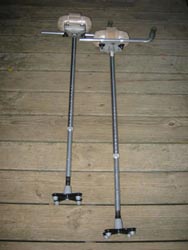Designers: Lindsay Boole and Hudson Levy
Client Coordinators: Christina Lomax
Supervising Professor: Dr. Larry N. Bohs
 Our client is an active woman with osteoarthritis. The goal of this project was to provide her forearm canes with shock absorption, and to develop brackets to mount the canes to her powered scooter. Shock absorber tips from commercial trekking poles were modified to fit her canes, and a combination of commercial and custom brackets installed to hold her canes on the scooter.
Our client is an active woman with osteoarthritis. The goal of this project was to provide her forearm canes with shock absorption, and to develop brackets to mount the canes to her powered scooter. Shock absorber tips from commercial trekking poles were modified to fit her canes, and a combination of commercial and custom brackets installed to hold her canes on the scooter.
How this project helped
The client commented, “The shock absorbers have already made such a difference. I already don’t think I could go back to the regular canes. They just take the impact so nicely and make my shoulders feel so much better. Being able to mount [the canes] on my scooter will make getting around so much easier, especially when I’m with [a child].”
The shock absorption component was developed by modifying the spring mechanisms from commercial shock-absorbing trekking poles. The commercial spring shock absorbers were composed of a threaded top stopper, a spring, a long hex screw, and a plastic molding. The poles were smaller in diameter than our client’s Guardian cane shafts, so we designed custom parts to fit the commercial shock absorbers into the Guardian canes.
 An aluminum top stopper was affixed with screws into the Guardian shaft, and a machined plastic sleeve was fit around the commercial shock absorber to increase its diameter. We also designed custom washers to fit between the top stopper and the spring, as well as between the spring and the molding, to minimize the wearing effects of continuous use. During initial tests, the torque exerted by the forearm canes caused the cane tips to rotate, loosening or tightening the shock absorber spring. To prevent this rotation, a setscrew was attached through the top stopper and into the long hex screw. The screw was tightened at a level of shock absorption comfortable for our client.
An aluminum top stopper was affixed with screws into the Guardian shaft, and a machined plastic sleeve was fit around the commercial shock absorber to increase its diameter. We also designed custom washers to fit between the top stopper and the spring, as well as between the spring and the molding, to minimize the wearing effects of continuous use. During initial tests, the torque exerted by the forearm canes caused the cane tips to rotate, loosening or tightening the shock absorber spring. To prevent this rotation, a setscrew was attached through the top stopper and into the long hex screw. The screw was tightened at a level of shock absorption comfortable for our client.
To attach the canes to our client’s powered scooter, we attached commercial EZGrip brackets on the rear fenders, and custom U-shaped guiding brackets on the front fenders (Figure 2). Both were secured with screws through aluminum plates, to evenly distribute the screws’ forces across the plastic surfaces of the scooter. Our client mounts the custom canes on her scooter by placing the bottom end of the shaft in the guiding bracket, then pressing the top of the shaft into the EZGrip bracket. The seat of her scooter rotates so that she can mount one cane on each side of the seat.
The cost of parts for the Custom Canes and Brackets was approximately $75.